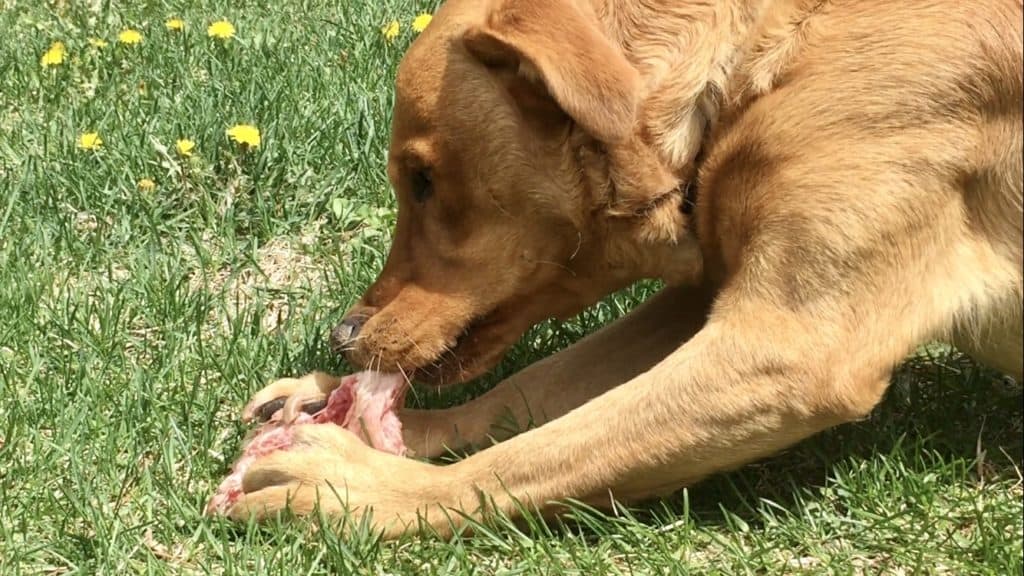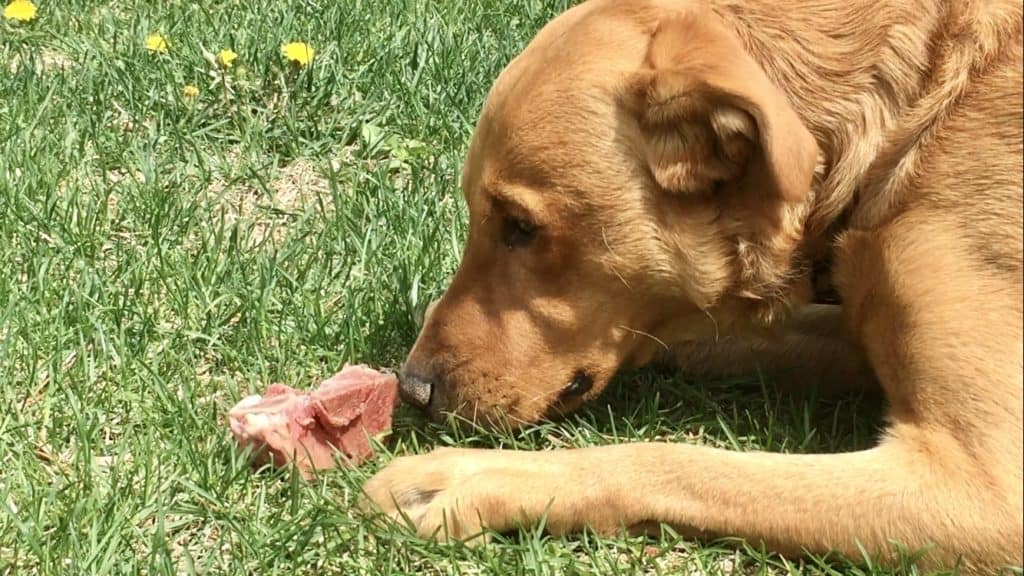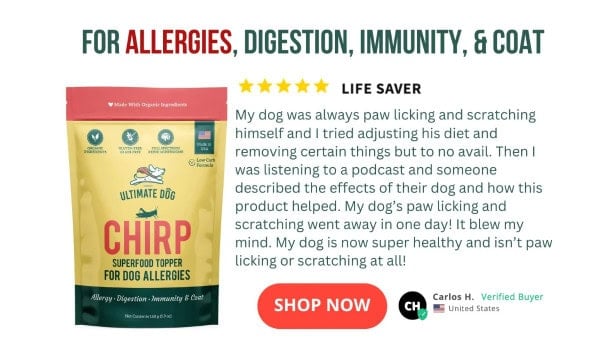Raw food fans love to talk about the many benefits of feeding raw bones to dogs. Meanwhile, many veterinarians and commercial kibble proponents warn that raw bones are dangerous and can even kill. So, which side is telling the truth?
In this article, we’ll take a deep dive into the common myths surrounding raw bones for dogs, as well as the many benefits associated with feeding raw meaty bones. We’ll also tell you everything you need to know about how to safely incorporate raw bones into your dog’s diet so they can experience those benefits without the risks.
Common Myths of Raw Bones for Dogs
Understandably, people would be squeamish about the idea of eating raw bones. Our species has, after all, been cooking our meat for thousands of years. And even when early humans did chow down on a raw deer or duck, they didn’t typically gnaw on the bones.
What we need to remember is that dogs aren’t like humans. Their ancestors have been eating raw meat and bones for millions of years. In fact, most domestic dogs were fed primarily discarded meat and bones before the advent of dog food in the 1920s.
This hesitance to accept that dogs can and do eat raw bones has driven a lot of common myths surrounding this biologically appropriate activity. The two most common, that raw bones can cause teeth problems and digestive issues, are both borne out of the same misconception.
Bones Are Bad for Teeth
Raw bones, whether from a cow or a chicken, are naturally much softer than the cooked bones most humans are used to dealing with.
For the typical healthy canine, chewing on a raw bone creates no more pressure on their teeth than chewing on a stick, nylabone, or tennis ball.
The idea that bones can cause teeth problems–specifically, that they can crack and break teeth–comes from the practice of giving dogs cooked bones. When bones are exposed to high temperatures, the collagen in them breaks down. This leaves behind a hardened matrix of calcium that is both denser and more brittle than a raw bone.
Cooked bones are often sold in feed supply stores and pet stores as an acceptable chew for dogs. Unfortunately, these types of bones pose a serious risk to dogs’ teeth, especially for dogs that are voracious chewers. Raw bones, on the other hand, are much more flexible and therefore much less likely to crack or break a healthy dog’s teeth.
Bones Can Cause Digestive Problems
Cooked versus raw also makes a huge difference in how safe bones are for dogs to swallow and digest. Both raw and cooked bones can be broken apart and consumed by voracious chewers. Large pieces tend to splinter off cooked bones fairly easily because they are so brittle. On the other hand, raw bones are typically gnawed down, releasing only small particles as the dog chews (assuming the bone is larger than the dog’s mouth).
The splinters that break off cooked bones can be very dangerous. They tend to be sharp and can easily cause damage to the dog’s mouth and throat and may even perforate the intestines. Raw bones, on the other hand, tend not to splinter. The rounded chunks that may break off are less likely to get caught in the esophagus. The high acidity of the dog’s stomach, which ranges between 1.08 and 2.05, easily breaks down these pieces of soft bone before they pass into the intestines.
The truth is, most myths regarding the risks posed by feeding bones are only true of feeding cooked bones. Feeding raw bones, assuming they are the appropriate size and type for your dog–more on that later–is typically very safe.
Benefits of Raw Bones for Dogs
While many of the risks associated with feeding raw bones are unfounded, plenty of benefits people talk about with regard to feeding raw bones are true. Feeding your dog raw bones is very beneficial to their overall health and provides an excellent outlet for natural tendencies like chewing.

Raw Bones Provide Essential Minerals and Vitamins
Bones are made up of a framework of collagen that is strengthened by calcium phosphate. All three of these nutrients are vital to the long-term health of your pooch.
Collagen is a type of protein that is used throughout the body to provide elasticity to different tissues. In addition to bones, collagen is found in very high amounts in joint tissue and skin. In fact, one-third of all the protein in the body is collagen. This vital protein is made within the body by combining several amino acids. It can also be gained by eating high-collagen foods such as raw meaty bones.
Calcium is the second most abundant nutrient found in bones. As any aging woman knows, this mineral is essential for bone health. Calcium also plays a vital role in heart health, muscle function, and nerve function. In addition, there is growing evidence that optimal calcium intake may even play a role in protecting against cancer.
Like calcium, phosphorus is essential for normal muscle and nerve function and a necessary building block for strong bones. It is also vital for cell energy metabolism and DNA formation.
If you’ve ever tried feeding your dog a homemade diet, then you probably know the importance of balancing calcium and phosphorus intake. When dogs consume too much phosphorus and not enough calcium, their bodies rob their bones of calcium to make up the difference. This causes a cascade of problems, from abnormal growth to kidney disease.
To avoid this, your dog needs to consume about as much or slightly less phosphorus than calcium.
Phosphorus is plentiful in muscle meat and is found in even higher amounts in organ meats. Calcium, on the other hand, is found only in very small amounts in meat. Bone, however, has about twice as much calcium in it as phosphorus. So, by including plenty of raw bones in your dog’s diet, you can easily match the amount of phosphorus consumed in the standard raw meat diet with this natural form of calcium.
If you feed a commercial diet, the amount of calcium and phosphorus in the diet has already been optimized. In this case, the excess calcium gained from eating bones will pass through the intestines and should not cause any issues with mineral imbalance.
Bones and bone marrow also contain plenty of vitamin D and vitamin B12, both of which are important for immune health. Glucosamine and chondroitin are also found in bones and bone marrow. Including these substances in your dog’s diet has been found to improve mobility, joint health, and reduce inflammation.
Raw Bones Improve Dental Health
All that calcium in bones is also vital for dental health in dogs. But the capacity of raw bones for improving dental health goes far beyond their mineral concentration.
The act of gnawing large recreational raw bones helps scrape plaque from teeth, essentially polishing those pearly whites and reducing the number of places bad bacteria can flourish in the mouth. The motion of chewing also stimulates blood flow in the gums, which helps bring white blood cells and antioxidants to the tissue around teeth. This allows the body to destroy pathogens before they have a chance to establish an infection.
Chewing raw bones also stimulates saliva production. Like blood, saliva contains aspects of the immune system that can kill pathogens before they have a chance to establish. The more bones your dog chews, the more saliva they will produce and the cleaner their teeth will get. Which, in turn, leads to healthier saliva. This feedback loop combined with the mechanical cleansing aspect of chewing raw bones leads to improved dog oral health.
Raw Bones Support Healthy Digestion
The mouth is the first stop in the digestive tract, so it is no surprise that improved oral health also affects the health of your dog’s digestive system. But the impact bones have on digestion goes far beyond that.
Feeding raw bones also has a significant impact on the gut microbiome of dogs. Studies have found that raw-fed dogs have higher concentrations of various microbes in their intestines and lower stomach pH, which helps kill pathogens and dissolve swallowed bones easier, than dogs fed commercial diets. These good bacteria play a substantial role in controlling the growth of common pathogens like e.Coli and salmonella.
On the back end, bones can help improve stool quality and consistency. Unlike omnivores and herbivores, which have evolved to use plant fiber as a means to regulate digestion, carnivores rely on the fibrous quality of bones to firm up fecal matter and keep them regular. Adding bones to your dog’s diet (after introducing them gradually) can help with both diarrhea and constipation.
Raw Bones Provide a Biologically Appropriate Energy Outlet
One of the most important impacts of adding raw meaty bones to a dog’s diet has nothing to do with their internal health.
Dogs are born chewers. Anyone who has ever owned a puppy can attest to that. Raw bones provide a safe, natural, and appropriate outlet for all that chewing energy. But, unlike traditional chew toys, bones go beyond just exercising your dog’s jaws.
The tactile sensation combined with the taste and smell help stimulate your dog in multiple ways. This leads to a dog that is both physically and mentally tired after a long bout of bone chewing. Introducing your dog to raw bones early on in their life can help keep their teeth off your furniture and on something that will help them grow stronger and healthier.

How to Safely Feed Your Dog Raw Bones
Now that you know how beneficial raw bones can be for your dog, we need to talk about how you can feed raw bones to dogs safely.
While chewing on and eating raw bones is an instinctual behavior for dogs, that doesn’t mean that it doesn’t carry some risk. But this risk can be greatly reduced by making sure you pick the right type and size of bone for your particular dog, storing the bones correctly before and during use, introducing them slowly, and making the right adjustments to suit your dog’s individual needs.
Pick the Right Type
When most people think of raw meaty bones for dogs, the first thing that comes to mind is either a big beef knuckle bone or a beef marrow bone. But there are a lot more types of bones to choose from. And that’s where things can get a little complicated. Luckily, though, most types of whole raw bones are a safe choice for your dog assuming they are size appropriate (more on that in a moment).
Which Bones to Avoid
The list of bones you should avoid for your dog, no matter their size, is relatively short. This category of “never feed” bones includes:
- Cooked bones
- Pork bones
- Rib bones
- Split bones
As we’ve discussed, cooked bones are much harder than raw bones and tend to split into pointy shards during chewing. These sharp pieces can get caught in the throat and perforate the bowel. Cooked bones should never be fed to dogs.
Pork bones, even raw ones, tend to be more brittle than other mammal bones. While many raw enthusiasts feed pork bones without issue, just as many warn against their use. Because there are so many other types of bones to choose from, we recommend playing it safe and staying away from any type of whole pig bone.
Rib bones are another controversial topic in the raw food world. Even beef rib bones tend to be narrow enough for most dogs to get their mouths around. And they are thinner than your typical bones, making them easier to break. If your dog gets a large piece off any type of bone, it can become a choking hazard. That is why we caution against feeding rib bones.
Bones that have been split down the center to expose the inner marrow are not good choices for most dogs. The cut sides of the bone are more prone to breakage than ends that have been cut vertically. Large pieces that break off these cut sides can easily become a choking hazard. These types of bones are widely available but should only be fed with extreme caution.
Which Bones to Use
After you account for the types of bones you should avoid, you still have plenty of options for the bones that are typically safe to feed dogs. Some of our favorites include:
- Raw poultry frames
- Raw marrow bones
- Raw knucklebones
- Raw poultry necks
- Raw poultry feet
- Raw rabbit vertebrae
- Raw meaty vertebrae
- Ground raw bone
Poultry bones are a safe choice for most dogs. They are very thin and safe for both young and old dogs to chew on. Poultry bones are available in a variety of types, including frames, feet (legs), and necks.
Marrow bones, which typically come from large mammals, are a great choice for recreational chewing. Just make sure they are cut vertically, not split (cut horizontally). Marrow bones are typically harvested from leg bones, which are harder than most bones. For this reason, these bones may not be the best option for dogs with dental issues, older dogs, or voracious chewers.
Knucklebones are similar to marrow bones in terms of density but are large enough that even the biggest dogs will struggle to take large chunks off of them.
Vertebral bones are another good choice for many dogs. These come in various sizes depending on the species and cut. Many of them contain a decent amount of meat as well–a fact many dogs love.
When most people talk about raw meaty bones, they’re speaking specifically about recreational-type bones. These are the kinds of bones that you can give straight to your dog and expect them to chew on for long periods. But bone can also be added to your dog’s diet in ground form.
Ground bone provides your dog with many of the benefits of feeding bone without risking choking or broken teeth. For old dogs, dogs with dental issues, and dogs intent on swallowing large pieces of bone, this may be the safer way to go.
Pick the Right Size
One risk many people point to concerning feeding raw recreational bones is the potential for the dog to choke. While this can happen, there are steps you can take to reduce this risk. Most importantly, you need to choose bones that are appropriately sized for your dog.
One rule of thumb is to only give your dog whole bones that are about the same size as or larger than their head. This will prevent them from trying to swallow the bone whole and reduce the likelihood that they’ll be able to get their jaws around the bone and bite off large chunks.
Looking for some specific recommendations of appropriate bones for your pup? Here are some general suggestions:
- Small dogs – chicken wings, chicken feet, poultry frames, poultry necks, and small cut marrow bones (1 inch wide). Most poultry bones will be thin enough for small jaws to gnaw through; just make sure the bone is large enough that they can’t swallow it whole. Thin cut marrow bones allow small dogs to chew at the soft inner marrow of the bone without having to chew through the hard outer bone first.
- Medium dogs – Marrow bones, smaller knucklebones, turkey necks, and poultry and rabbit vertebrae. The key to safely feeding medium dogs is to use bones large enough that they cannot swallow whole. If you have a strong chewer, then you’ll want to feed denser bones that are harder to split, such as marrow bones, or bones too big for them to put their jaws around, such as knucklebones.
- Large dogs – Large marrow bones, knuckle bones, large animal vertebrae, poultry necks, and chicken wings. Large dogs can safely eat bones about the size of their heads and small bones that can be swallowed whole.
Remember, this list is just a guide. Always supervise your dog closely as they get used to eating raw bones and make adjustments based on how vigorously they chew, how strong their jaws are, and how likely they are to try and swallow large chunks of bone.
Once a dog has chewed a bone down to the point that it fits in its mouth, it’s time to throw that bone out.
Keep Them Frozen
Healthy dogs are not nearly as susceptible to many of the pathogens found on raw meat as humans are. But it is still important to take steps to ensure the raw bones you feed your dog are safe. One of the most important factors in keeping bones safe is assuring they stay frozen from harvest until feeding.
Generally, raw bones sold at feed stores and pet supply stores are a safe choice for your pet. These items are packaged and marketed for sale and therefore have to follow specific storage regulations. Soup bones and other bones marketed for sale at grocery stores are an even safer bet.
Scrap bones purchased at the butcher can be questionable as these are typically regarded as waste material. Once these bones are removed from the cuts of meat, there is no guarantee that they will be put back in the freezer for storage. If you go this route, make sure to ask the butcher if the bones were ever allowed to thaw.
Once you get the bones home, be sure to store them in the freezer until you are ready to give them to your dog. Allow your dog to chew on them for only an hour or so at a time, then store them in the refrigerator until the next chew session. After three or four days, it is best to throw the old bone out and start fresh with a frozen one.
Introduce Them Slowly
Dogs on kibble diets have a different gut microbiome than raw-fed dogs and wolves. They also tend to have less acidic stomachs. Both of these factors mean that dogs that are new to raw bones are likely to have some digestive problems if they are allowed to eat too much bone too fast.
The best way to introduce dogs to bones is by adding a small amount of ground bone to their meals first. Start very small and increase until the ground bone makes up about 10% of their meal. If they tolerate this change well, you can begin to introduce recreational raw bones.
Start with short, 15 minute chewing sessions each day. Most dogs do best with softer bones at first. These won’t damage your dog’s teeth even if they get overly excited and chew too vigorously. Once they are more accustomed to getting bones and their stomachs have gotten used to digesting them, then you can transition to more substantial recreational bones.
Make Adjustments for Individual Needs
In the end, feeding raw bones safely all comes down to catering to your dog’s individual needs. Some dogs are more likely to try and swallow large bones than others. Some have jaws that are too powerful for even the largest marrow bones. You will need to adjust what kinds of bones you feed based on their behavior.
You also need to make special considerations for your dog’s personal health. Dogs with pancreatic issues should not get marrow bones due to their high-fat content. Very old dogs and those with bad teeth should only get poultry or ground bone.
The best way to find out what your dog needs is to watch them carefully as you introduce them to raw meaty bones and make changes as needed to assure recreational bone chewing remains a safe and enjoyable activity.
Raw Bones Are Part of a Balanced Canine Diet
Raw meaty bones carry a lot of stigma. Many people believe they are dangerous and bad for dogs’ teeth and digestive tract. But the truth is, raw bones provide a long list of benefits from adding many essential minerals to your dog’s diet and giving them a healthy outlet for their energy to helping improve oral and digestive health.
As long as you choose the right type and size of bone for your dog and introduce them slowly while making adjustments for the dog’s individual needs, feeding raw bones to dogs is a safe and beneficial practice.
Sources
The Arizona Science Center. (2011, February 02). Bone Experiments. ASU – Ask A Biologist. Retrieved January 6, 2022
Bonjour, J. P. (2011). Calcium and Phosphate: A Duet of Ions Playing for Bone Health. Journal of the American College of Nutrition, 30(sup5), 438S-448S.
Brooks, Wendy. “Calcium Phosphorus Balance in Dogs and Cats.” Veterinary Partner, VIN, 5 June 2019.
Link, M. R. S. (2019, March 27). Bone Marrow: Nutrition, Benefits, and Food Sources. Healthline.
PetMD Editorial. (n.d.). How to Use Bones in a Dog’s Raw Food Diet. PetMD.
Sagawa, K., Li, F., Liese, R., & Sutton, S. C. (2009). Fed and fasted gastric pH and gastric residence time in conscious beagle dogs. Journal of Pharmaceutical Sciences, 98(7), 2494–2500.
Schmidt, M., Unterer, S., Suchodolski, J. S., Honneffer, J. B., Guard, B. C., Lidbury, J. A., Steiner, J. M., Fritz, J., & Kölle, P. (2018). The fecal microbiome and metabolome differs between dogs fed Bones and Raw Food (BARF) diets and dogs fed commercial diets. PLOS ONE, 13(8), e0201279.

Sara Seitz worked in the pet industry for over a decade. In addition to being a certified dog trainer, Sara gained experience working as the general manager of a dog daycare and boarding facility, as the creator and manager of a pet sitting company, as a groomer, and as a dog behavior evaluator. She also has a bachelors in animal behavior from CSU. Currently, Sara works as a freelance writer specializing in blog, article and content writing.




Leave a Comment